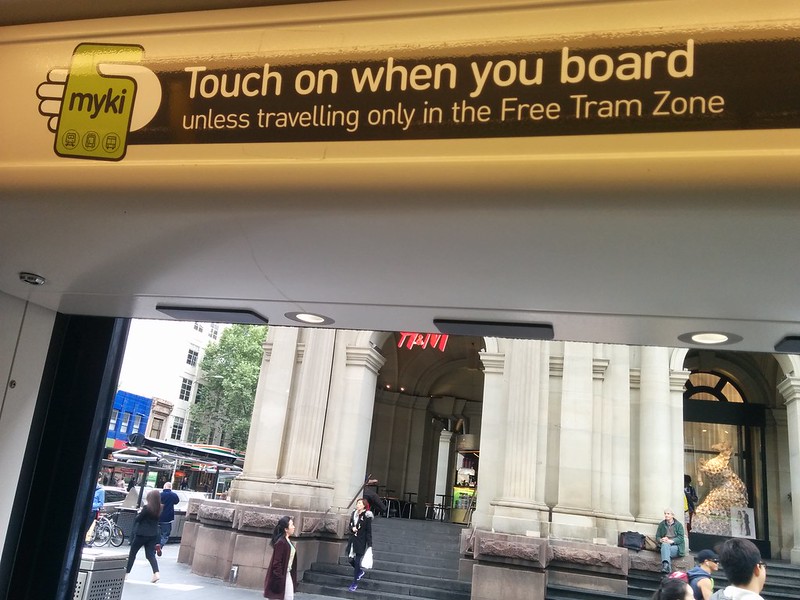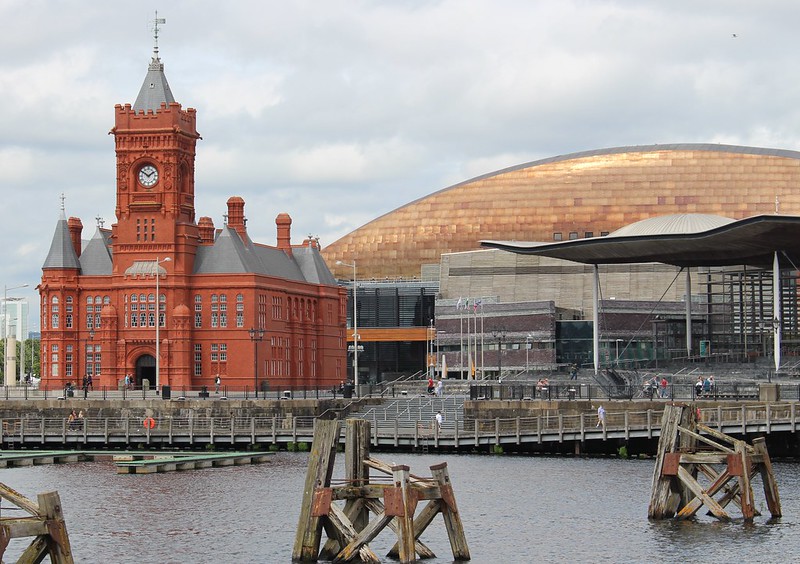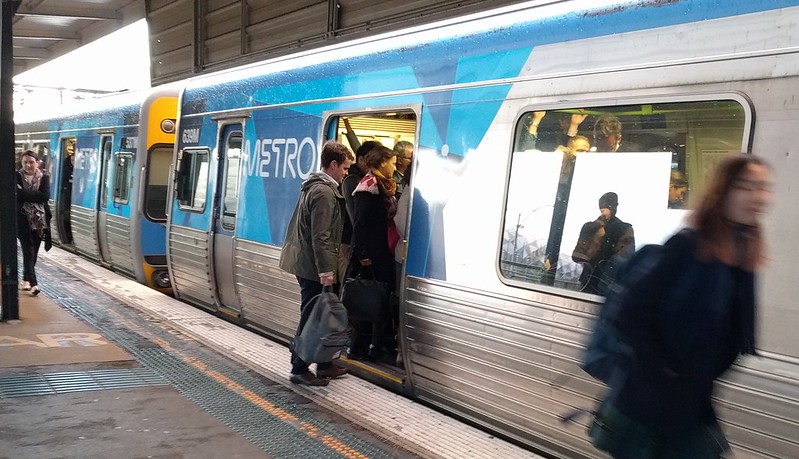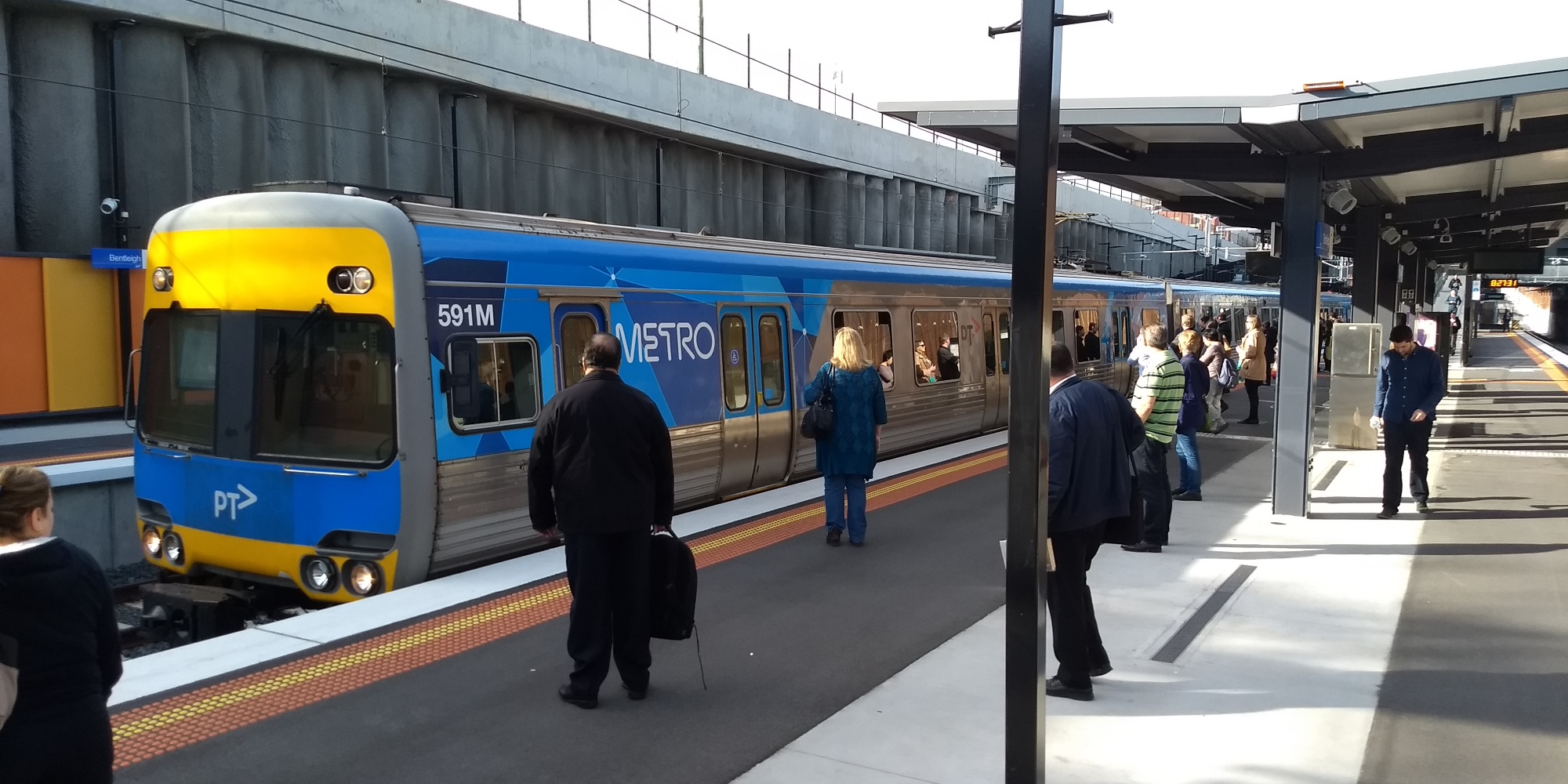From time to time the topic of free public transport comes up, most recently because of changes in Estonia.
I think it’s a distraction from far more important issues.
I just wanted to address a few points about it. Apologies for the rambling.
Would it be a good idea in Melbourne and/or Victoria?
I don’t think so.
The first point is the cost: the PTV Annual Report indicates around $800 million is collected in fare revenue every year.
Even allowing for the running costs of the ticket system and fare enforcement, hundreds of millions of dollars would have to be found to cover that.
That’s money that wouldn’t be available for upgrades, which are a far higher priority, because the main reason people don’t use public transport isn’t the fares, it’s the service quality.
If the system goes free, assuming that at least some of the shortfall is via higher taxes, you’d have a lot of people paying more for a service they can’t practicably use, which brings me to the next point.

Would free PT get more people on board?
Melbourne’s existing free public transport is an indicator of what would happen if the whole system was free.
The usable, frequent services would be swamped with people. They’d need upgrades to keep up with growth — upgrades which would be far more difficult if revenue isn’t growing with patronage growth. Example: the Free Tram Zone; free New Years Eve trains.
You’d also lose any peak/off-peak pricing mechanism that can moderate peak demand and help encourage off-peak travel. This is used heavily on V/Line (30% discount outside peak, and for all trips that don’t go through Zone 1), and also on Metro (100% discount before 7:15am on weekdays), though arguably this could be used more extensively.
The infrequent, less usable services — such as suburban buses — still wouldn’t get a lot of use. Example: Seniors and Myki Pass-holders on weekends. Some use the buses, but plenty would rather drive, even if they can use public transport for free (or for no extra cost with their weekday ticket).
And that’s a problem if one of the prime aims is to increase public transport usage. Those middle and outer suburban areas where most people travel day to day is where public transport is failing to win market share, thus driving dominates. It would continue to be the case.
If a suburban bus is once an hour (and plenty are), then it’s not suddenly a compelling service if it becomes free. They need more services, not free services.

It costs more to collect fares than the revenue
No, completely wrong.
Myki was an expensive system to build; around $1.5 billion including ten years running costs = $150 million per year.
It’s still expensive. The recently signed operations contract is $700 million for seven years = $100 million per year.
(Sydney’s Opal card system is also expensive, at $1.2 billion for 15 years. That’s a bit cheaper, but these systems can be very expensive when they involve coverage of a large network, requiring lots of hardware — whether or not it’s established technology or being built afresh.)
So yes, ticket systems cost a lot of money. But even if you supposed that on top of the $100-$150 million per year for the ticket system, ticket inspections were costing another $50 million per year (and assuming those staff aren’t needed anyway for other purposes such as safety), that’s still around $600 million per year lost if fares aren’t collected.
Or to put it another way: if Myki hadn’t been built, instead the system could have been fare-free… but only for about two years.
There would be some benefit from going fare-free: better passenger flows in and around stations, as fencing and gates are removed, and on and off trams and buses. But at a huge cost, and these issues can be ameliorated in other ways.

But Estonia has free public transport!
No it doesn’t. If you look beyond the headlines, you’ll discover that recent changes have made regional buses in Estonia free.
Free journeys will be available for all Estonians using county buses, but won’t be available on trains (although enhanced subsidies will make tickets on the state-owned rail network cheaper). And in Estonian cities outside of Tallinn, all passengers will still have to pay to use all modes of public transit, including buses. — Huffington Post
It’s apparently not even all county regional buses:
To date, not all Estonia’s 15 counties have taken up the offer, though the free-fare zone is set to cover large areas of the country. — European Sting
So it excludes rail services, and city (suburban) buses — which would account for the majority of passengers.
Tallinn, the capital of Estonia (population 610,000) does have free buses, trolley-buses, trams, ferries and trains within the city limits, but only for residents.
People still use a smartcard, but the cards issued to local residents give them free rides. Which means the system still incurs the cost of running the ticketing system. In fact Wikipedia notes that services are stopped during ticket checks (though this practice may not still be current) — so it’s really not a fare free system at all.
Problems aside, was Tallinn’s free public transport a success? That depends on how you define success:
…a 2016 analysis of the Tallinn scheme found it didn’t really encourage many people to stop driving.
In 2014, a year into the experiment, the use of public transport had increased by 14%. However, car use only declined by 5%.
In fact, it was walkers who hopped on buses, as the number of trips made on foot dropped by a staggering 40%.
And while the share of car use marginally decreased, the average distance travelled by car actually went up. — European Sting

Wales has free public transport!
No it doesn’t. Wales has free bus services on weekends only… but only for 9 regional bus routes run by one operator, the Welsh government-owned Travel Cymru. It appears to be a measure designed to stimulate tourism.
The scheme excludes rail services, and all other bus services — including bus services within cities.
Hasselt, Belgium has free public transport!
No it doesn’t. They had free buses (not other modes) from 1997 until 2013 when they scrapped the scheme because of cost — in part the costs of running services to cater for higher patronage. The buses are still free for those under 19.
Hasselt isn’t a big city, in any case – it has a population of only about 71,000 people. That means it’s not a good example to point to when arguing for a large city to go fare free.
Paris…
The (socialist) Mayor of Paris has proposed it, but the idea has been opposed by others.
As far as I can make out, as of 2018, there is no major city in the world (of say more than a million people) where all public transport is free.
But the roads are free
Toll roads are an obvious exception, but even “free” roads aren’t actually free. They are heavily subsidised, but motorists still have to pay fuel tax at the pump, and registration and licencing fees.
Public transport is subsidised too of course. This is no reason to cut out fare collection and make the subsidy even bigger.

Priorities
Chris Hale recently wrote in The Age that: “a public dollar frittered on fare discounting is invariably a waste, whereas that same dollar invested in better off-peak service gets great results.”
Fares certainly need to be affordable. Part of that is addressed ensuring there are concessions to those who need them.
But in any big city, even those hailed as having great public transport, service and infrastructure improvements are needed.
In fact the best public transport cities tend to get into a growth spiral of patronage – they need ongoing investment. It costs, but it’s good for their city.
All of which means that in any city, with even a moderately successful public transport network, given the huge amount of money raised from fares, it’s very difficult to envisage a time when making the service free would be a priority, or even desirable.
- More reading: PTUA – Myth: Making public transport free will encourage use and political support
- Update 2021: Estonia’s National Audit Office studied the free public transport in Tallinn, and concluded that it did not fulfil the goal of reducing car journeys.
- Update 2023: PTV fare revenue fell during the pandemic, but has now recovered somewhat to $617m for 2022-23

19 replies on “We need better public transport, not free public transport”
That’s a good point about free public transport in one of those cities actually cannibalising walking trips rather than reducing driving.
That’s exactly what’s happened with me and the Free Tram Zone in Melbourne.
I live in the CBD, and I much more likely now to hop on board a tram for a short trip I would’ve previously walked. Not really good for my health or congestion!
Isn’t the Melbourne FTZ funded from the Parking Space Levy, as such services are in Perth and Sydney? There is often also other co-funding for such services, typically from local councils, businesses and universities. Fare-free doesn’t equate to revenue-free – don’t confuse the two.
The reasons for free central area transit, pretty consistently around the world, revolve around the benefits they bring to city centres including revitalisation (particularly where they are adversely affected by car-based suburban centres) and reduction of automobile pollution and congestion, as well as reducing wastage of valuable land for carparking. Such services are typically fed from carparking on the periphery and thus reduce traffic coming into the centre.
They also attract people who don’t normally use public transport to appreciate the benefits of public transport which can have spin-off effects. In my part of the world in Wollongong, the 55A/C bus has brought a 15% increase in public transport usage in the city which as a result now has the highest public transport usage of any regional city in Australia. At 3.5 million passengers per year it is one of the busiest individual bus routes in Australia. Fare-free, when properly targeted, can be outstandingly successful. The four CAT routes in central Perth attract 8.5 million passengers per annum between them. As an advocate of public transport, I would see this as something to be celebrated.
There are such fare-free services (bus and/or tram) in 10 Australian cities and scores around the world. Some general background:
https://en.wikipedia.org/wiki/Free_public_transport
https://en.wikipedia.org/wiki/List_of_free_public_transport_routes
I’d say that in Melbourne the problem is simply a lack of tram capacity – the whole fleet needs to be 30 metre low-floor trams. Although this suggestion is met with horror by tram fans, I’ve long suggested that an interim measure to address the glacial progress of tram fleet replacement in Melbourne should be acquisition of a fleet of fully low-floor articulated buses, both to infill between trams on routes with poor accessibility and to maybe run another fare-free service in the CBD to take the pressure off the trams – perhaps on a circuit that the trams aren’t filling.
@Tony P, the FTZ came in well after the car park levy was introduced. Someone will correct me if I’m wrong, but I’m not aware of any explicit linking of the two.
The car park levy was used for a time to do localised upgrades to footpaths and other facilities, as well as to fund a CBD “shuttle” bus loop. The latter was never very popular, since it was quite infrequent, and tourists preferred the City Circle tram.
In any case, the current debate is about metropolitan-wide free public transport, not city centre.
See also, this previous post on the FTZ: https://www.danielbowen.com/2015/01/19/free-tram-zone-pros-cons/
Free PT might not be realistic, but the fares for Melbourne are expensive. The regular fare increases in excess of inflation over recent years don’t help. The money lost on the FTZ would have been much better used to keep down, or heaven forbid, reduce all PT fares.
On a related issue, I’m increasingly of the mind that the fare system for metro Melbourne really needs to be thrown out with something new in its place. The abolishing of Zone 3 was a mistake I think as it has led to essentially an expensive flat rate system where going two stops on a suburban tram is the same price as taking the train from Hurstbridge to Frankston. Makes one wonder why the government bothered spending $1.5B on Myki if this is the simple fare system it has to implement. I usually prefer PT fares to be kept simple (so I’m not a fan of peak/off peak fares) but some sort of distance based model might be needed in 5-10 km sections.
I use to walk around the city. Now I catch a tram in the CBD – because it’s free.
So I agree with you Daniel that making PT free will encourage a lot more people to use it, without the funding for additional services to cope. In fact, less funding.
I would like if we extended the FTZ up St Kilda Rd at least as far as the NGV (and preferably the Shrine of Remembrance).
We definitely need greater investment in frequency and reducing overcrowding, and we also need to resist upwards pressure on fares. It’s not okay when fare rises consistently outpace inflation.
I think the quick answer to metropolitan-wide fare-free public transport in Australia is that presently there simply aren’t the fleet sizes and often system capacity to handle the extra demand for public transport that would result. The surge of demand on the fare-free central area circulators alone after they’re introduced (commonly patronage growth of millions of passengers per annum) is a micro example of what would happen on a metropolitan-wide scale. It sounds like a good formula for operational collapse!
50% of trips in Vancouver are done without a car:
https://www.vox.com/science-and-health/2016/12/9/13897078/walkable-vancouver-video
We should be aiming for that and one of the steps should be to make PT free during the off-peak. Inequality is at a 70 year high and free off-peak travel will help the poor.
Petrol tax revenues are about to disappear as people switch to hybrid cars. A land tax should be put in and already exists in the ACT:
https://www.canberratimes.com.au/politics/act/bill-to-help-increase-act-land-tax-by-45-per-cent-over-five-years-20180412-p4z98j.html
The poor own no land, so it is a great tax.
https://www.theage.com.au/business/companies/bill-shock-for-landlords-as-land-tax-skyrockets-20170224-gukiya.html
Cheaper off-peak and short trip fares could and probably should easily be introduced.
Special passes for the poor to get free PT in the off-peak may even be a reasonable idea.
General free PT is still a bad idea given its undermining of walking and cycling, disproportionate tendency to fill the busier areas of PT and its replacement of incentive to increase services with disincentive. The free tram zone should be scrapped.
Yeah, I too would question the point of spending money on Myki for such a simple fare structure. Sydney’s isn’t really cheap either, but at least it’s distance-based and thus makes better sense. If I remember correctly, a trip on a bus in Sydney for the entire length (generally 10-15kms) would only cost $4-5 at most, whereas according to the PTV website, it is actually similar for even a single stop with Melbourne’s trams? (assuming Zone 1+2) I thought the whole point of having electronic fare payments was to allow for various discounts/surcharges depending on who (student/pensioner/full fare) is travelling at what time of day (on-peak/off-peak), for how far, and in which mode (bus/tram/train). The simplified structure without any discounts is more for paper-based tickets – speaking of which, almost everywhere else has and Melbourne really should reinstate for people travelling occasionally or as an emergency measure (read: when you lost your myki).
Wasn’t one of the key reasons for making trams effectively all one zone (Z2 only journeys excepted) to eliminate the need to touch off, which is just not practicable on packed trams. ISTR that TPTB only realised this at a late stage of Myki planning.
@Jacob, it’s actually 50% of trips within the City of Vancouver – just the central council area (population 631,000), not the entire metropolitan area (population 2.6 million). See: 50% of trips in Vancouver made by walking, biking or transit: report
It’s also worth noting that Vancouver doesn’t have any off-peak discounts, though it is a single zone fare (instead of up to 3) after 6:30pm on weekdays, and all day on weekends and public holidays.
@TonyB, yes tram zones were altered due to Myki – not just the crowding, but also the lacklustre speed of the Myki devices. (The newest ones are faster). But this only affected a few kilometres of just three routes (75, 109 and 86).
The subsequent zone changes have effectively done the same for trains and buses.
Daniel, I was not aware of the 631,000 figure. Thanks for that.
But Vancouver does have cycleways – not sure how many km – and they are probably free to use.
Most people in Copenhagen and Amsterdam probably get around on bicycles. The cycleways cost money to maintain – just like railways – but are free to use and funded somehow.
I used to walk home from school because I was too poor to afford a bus ticket. Free off-peak bus travel would help poor families and of course get people out of peak hour services. Some people drive instead of using PT because they think it is cheaper to drive. Electric cars are going to make them more inclined to think that way. If off-peak tickets are $0, there is no argument that $0 is cheaper than $1.
Bike paths, like roads, are public infrastructure mainly for private vehicles (which have private operating costs) that are mostly infrastructure cost and, with lots of entry and exit points, are complicated to charge for travel on. Public transport has public services (with public operating costs) that have much fewer entry points and thus have both a higher need and higher ability to charge for usage.
The myki system as it relates to the interaction between metropolitan and regional travel needs a complete overhaul to remove all of the anomalies. At present I think there are 6 fares for travel between Southern Cross and Geelong depending on time of day and if you are prepared to break your travel to touch off and on at a station in Zone 2.
Direct, leaving Southern Cross between 4-6pm – $13.20
Direct, leaving Southern Cross at other times – $9.24
Metro to Sunshine, arriving before 7.15am, then to Geelong – $3.50
Metro to Sunshine, arriving after 7.15am, then to Geelong – $7.80
To Deer Park, then to Geelong – $4.86
To Lara, then to Geelong – $6.70
The marginal cost of continuing a journey one station past Lara (to Corio) is $7.30 (peak, or $3.82 off-peak) – more than three times the cost of a single trip between Lara and Corio ($2.40). There is a massive difference between the cost of a Zone 1/2/3 trip and a Zone 1/2 trip, especially in peak times. It’s not so much a case of an off-peak discount, but a peak penalty! And then a penalty for travelling outside the ‘metropolitan’ area!
But I’m not sure if the answer is to reduce V/Line fares.
I think we need both. Paid public transportation like buses and MTA should be better managed and maintained. Nevertheless, urban infrastructure should accommodate free public transportation, make bike lanes and walkways that are easily and readily accessible.
I think public transport could work with a small fare. Something very cheap that still generates enough profit to use it on maintenance and improvement of the system.
Free doesn’t guarantee that you’re going to be able to catch the public transportation since is going to be so packed. I think is better to have a small fare for the public transportation and more places for people to run their bikes and skateboards as a free form of transportation.
[…] More reading: We need better public transport, not free public transport […]